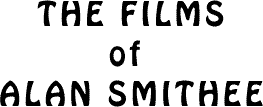![[M/tv Logo]](mtvsml.gif) |
 |
|
On the Set
Smithee at
|
The Seme-y Seams of Seem:
The Artifice Language of Alan Smithee
![]()
One anecdote is repeatedly repeated concerning the Nouvelle Vague stage of auteur Alan Smithee's oeuvre: having heard and not seen Truffaut's Les Quatre Cent Coups — (The 400 Blows) — praised as an instant film classic, he misheard the title as Les Gateaux sans Culs — (The Arse-less Cakes), which he imagined to be a throwback to the French Surrealist School. Smithee then acted on this misconception to make two astonishing films, The Story of 'N' (1959) and L'Oeuf (1960), both of which are rich combinations of genre film, syntagmatic experimentation, the Monroe Doctrine, and cameo appearances by film icons Lee Van Cleef and Patricia Hitchcock.
The Story of 'N' starts out with a deep focus shot of an empty Paris Street. This shot is held for 10 minutes as we see the neighborhood waking up — dogs marking their territory, men with baskets full of baguettes, gendarmes directing clusters of uniform-clad schoolchildren, and grips, PAs and befuddled passers by. This scene ends with the offscreen nasal beep of an out-of-control Citroyen, as the camera and the viewer are propelled forward in a sickly lurch. The next shot introduces the character 'N', played by faux-American Johnny Halliday, dickering at a chinese laundry over the matter of an unstarched collar. The launderer is entirely hidden behind a wall of carefully wrapped laundry, and consequently is unseen and unheard. As 'N' stalks offscreen, the camera reveals he has been complaining to a drying shirt. Then, in a brief homage to John Ford, 'N' mounts a horse and gallops though the markets of Les Halles. In a brief homage to Orson Welles, he burns a sled. In a brief homage to Frank Tashlin, he crosses his eyes and flaps his arms like a chicken. Then — in a scene which consigned this film to Art Houses — 'N' visits what he thinks is a church but is instead the stage door of the Folies Bergere.
Behind this simple plot, Smithee wove in a texture of self-revelation as microphones, electricians, caterers, collection agents, and other members of the production team made improvised onscreen appearances. These come in so often that one wonders if in fact 'N' is actually acting a role or merely captured in his normal routine. When Van Cleef passes 'N' a cigarette, it's as if the imaginary has made contact with the symbolic. In many scenes, the camera lens is smudged, partially obscured by a thumb, or covered with a lens cap to ring attention to the filmic process.
In L'Oeuf, Smithee himself is seen waiting at his breakfast table, eating a soft-boiled egg. He is continuously interrupted — in an homage to Bunuel and Jack Benny, no doubt — by various crackpots and annoying waitstaff. This is all done in the most deadpan way, with barely a shot-counter shot to relieve the static eye. Even after Smithee leaves the table, the camera lingers as it is cleared, cleaned and reset. Through the window one can see the street, where someone else seems to be shooting another film. In a final shot, you can see Smithee fighting with the other production crew.
Certain leitmotives appear throughout the two works — the autodidactic revelation of "Camera" as a major player, the natural soundtracks, and even the appearance of M. Cabal, the bill collector in both films. One of my graduate students did a breakdown of each of these films and counted more than 150 cigarettes being lit, roughly one a minute. Several times, Smithee invokes Plato's cave by panning to a wall and having the action, such as it is, played in shadows and objects thrown at the wall.
You can see that Andy Warhol stole a lot of his ideas from Smithee!
![]()